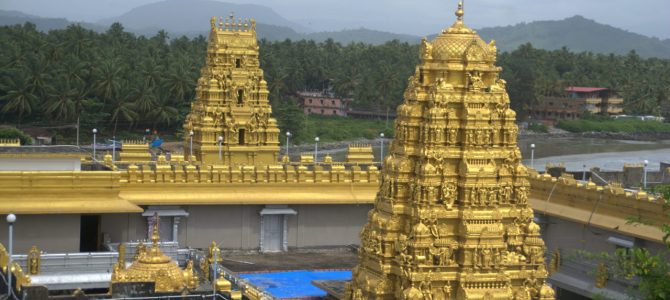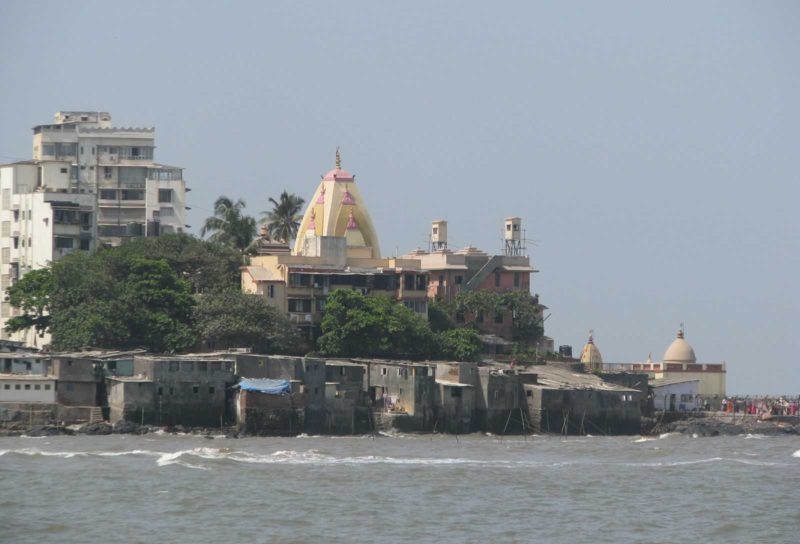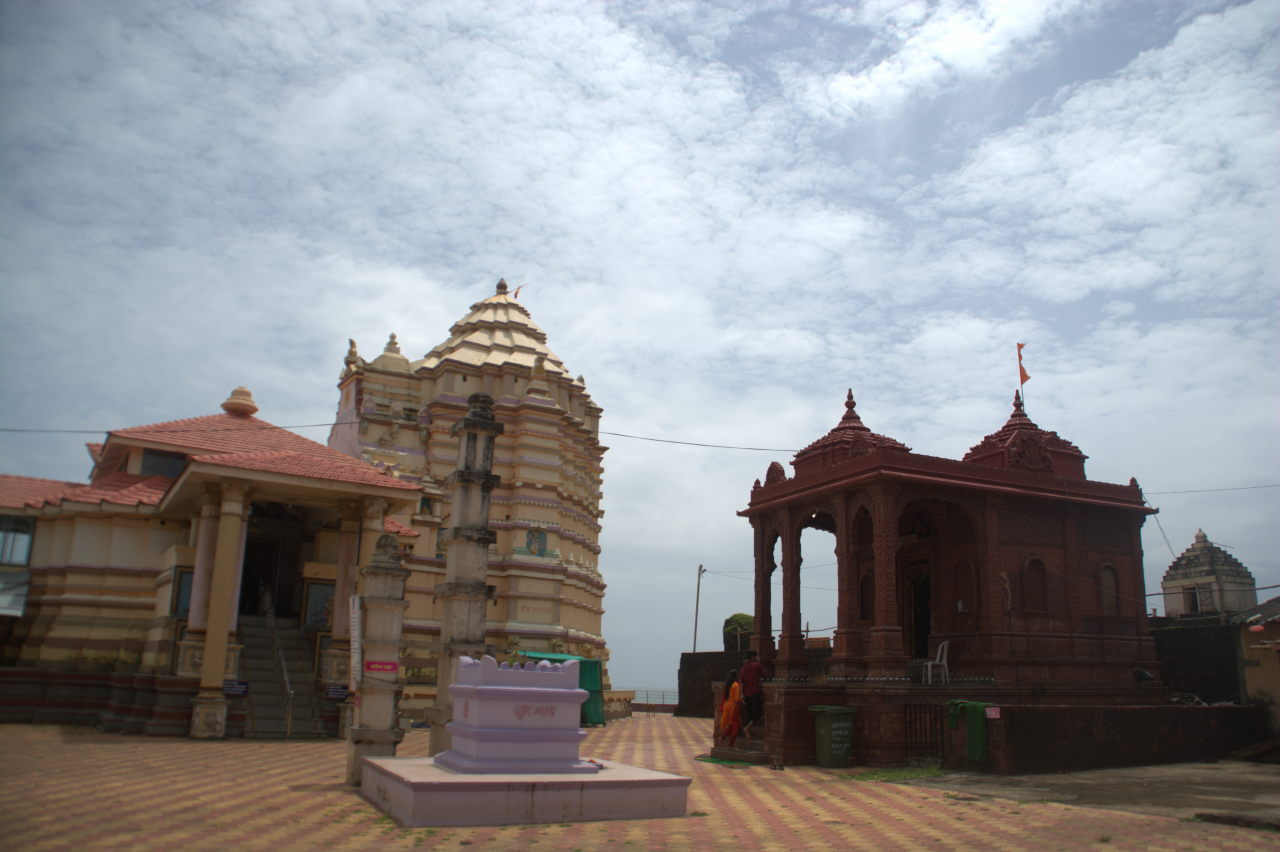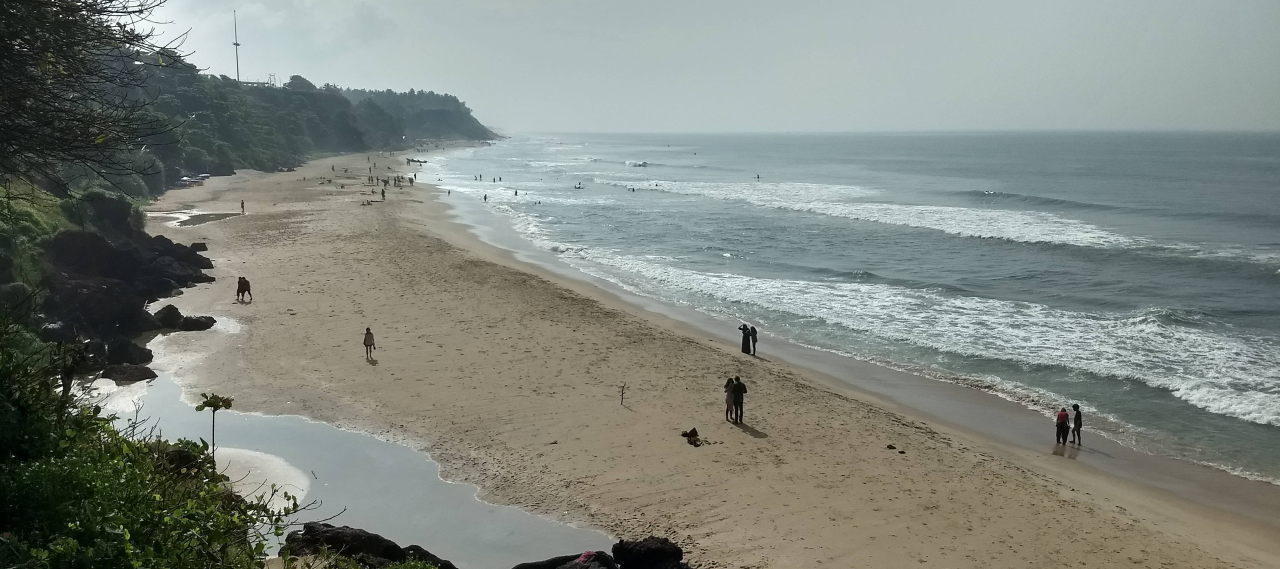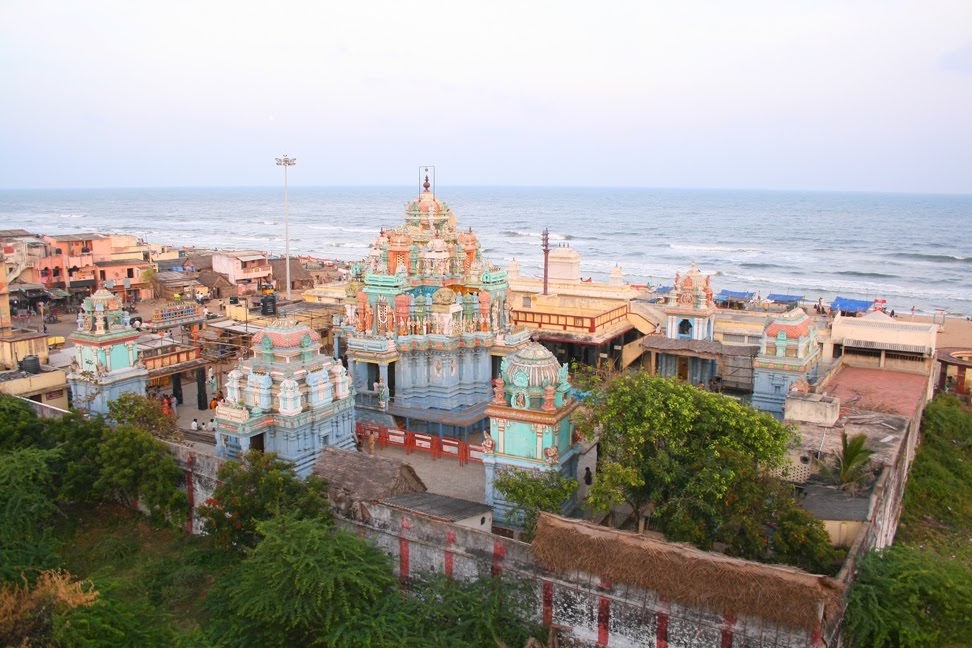India is a beautiful country. It is also a religious country. Places of beauty are also Kshetras with major temples. Things look especially beautiful if a major temple is on a beach. The sound of temple bells on one side is matched by the rhythm of waves on another. The smell of camphor mixes well with the fresh salty smell of sea water. Here are some sea-side temples from India. This is not an exhaustive list. It is just some temples we have covered during India 360 or other trips.
1. Mahalaxmi, Mumbai, Maharashtra
We start from our hometown. Mahalaxmi temple was built in the 18th century and has quite a story behind it. Along with Prabhadevi locality’s Siddhi Vinayak temple, Mahalaxmi is a flagship temple in Mumbai. The sight of the Hindu Mahalaxmi temple with the Haji Ali Dargah a few metres away is a famous landscape of the city. The temple overlooks the sea, with the waves regularly crashing at the rocks at the base of the temple. Diwali is a peak time for this temple since that is when a major Laxmi pooja happens.
It is said the the temple was built as part of the Vellard project, which was a project to connect all seven islands of Mumbai through causeways in the sea. The wall of the causeway connecting Tardeo to Worli kept collapsing. In his sleep, the chief engineer of the project, an Indian, dreamt that there was an idol of Goddess Lakshmi inside the sea. Acting on his dream, he was bold enough to initiate a search operation. To his surprise, the dream was a reality and the statue was recovered. A temple was built with the statue consecrated. After the temple was built, the Worli causeway project or any of it for that matter never faced trouble from the sea!
The easiest way to reach the temple is by travelling by a Mumbai local train to Mahalaxmi railway station and taking a shared taxi to the temple. Buses are also available with excellent frequency. All buses that travel from south Mumbai (i.e. Marine drive, Churchgate) to Mumbai Central / Tardeo or Worli pass through Mahalaxmi.
2. Ganpatipule, Ratnagiri district, Maharashtra
About 30 km from Ratnagiri city is the Ganesh temple of Ganpatipule. The idol of this temple is said to have sprung up from under the beach sand. This is following a legend that Lord Ganesh shifted his location to here from another beach named Ganeshgule. A full-featured temple with a trust now stands at the beach. Ganpatipule is still not urbanised and surrounded by hills, coconut and mango plantations and rice paddy. The village has several economically priced lodges for the devotees.
Ganpatipule is best reached by taking a Maharashtra State Transport bus from Ratnagiri city. There are also six-seater vehicles serving as shared taxis.
3. Kunkeshwar, Sindhudurg district, Maharashtra
In Sindhudurg district, 16 km from the town of Devgad is the beach-side Shiv temple. It is said that the temple was built by a sailor whose ship was caught in a turbulent sea. When the sailor saw a lamp on a beach at a distance, he thought that it was divine intervention. He prayed to the divine to rescue him and promised that he’d build a temple if he were to survive. The ship landed right near a Shiv Ling on the Kunkeshwar beach.
True to his promise, the sailor built the temple, which still stands today. Inside the Kunkeshwar temple is a portrait of Lord Shiva with a rugged beard.
The nearest railway station to Kunkeshwar is in the town of Kankavli, from where state transport buses are available. There are both economical lodges and a three-star resort at Kunkeshwar.
4. Gokarna, Uttara Kannada district, Karnataka
Gokarna is gaining popularity as the town with beaches not so crowded as Goa. The beaches in Gokarna, Om and Kudle, draw several tourists from abroad. But the town started as a Kshetra and most Indians still visit it as a pilgrimage.
The town is known for its Shiva temple, the chief deity being Mahabaleshwara. It is said that the Shiva Linga present at Gokarna is the Atma Linga. As per ancient legends, anyone worshipping the Atma Linga could attain immortality. Lord Ravana is said to have tried to grab the Atma Linga from Gokarna, but was unsuccessful in doing so. He did get a few pieces of it and scattered it around. One place having the scattered Atma Linga is the town of Murudeshwara, discussed next.
Despite being in Karnataka, Gokarna has special significance to Keralites. This is because Lord Parashurama is said to have thrown his axe into the sea, standing at the shore of Gokarna. The sea God Varuna yielded and made a piece of land appear from inside the sea. This land is said to be present day Kerala and hence that state is called “God’s own country”.
5. Murudeshwara, Uttara Kannada district, Karnataka
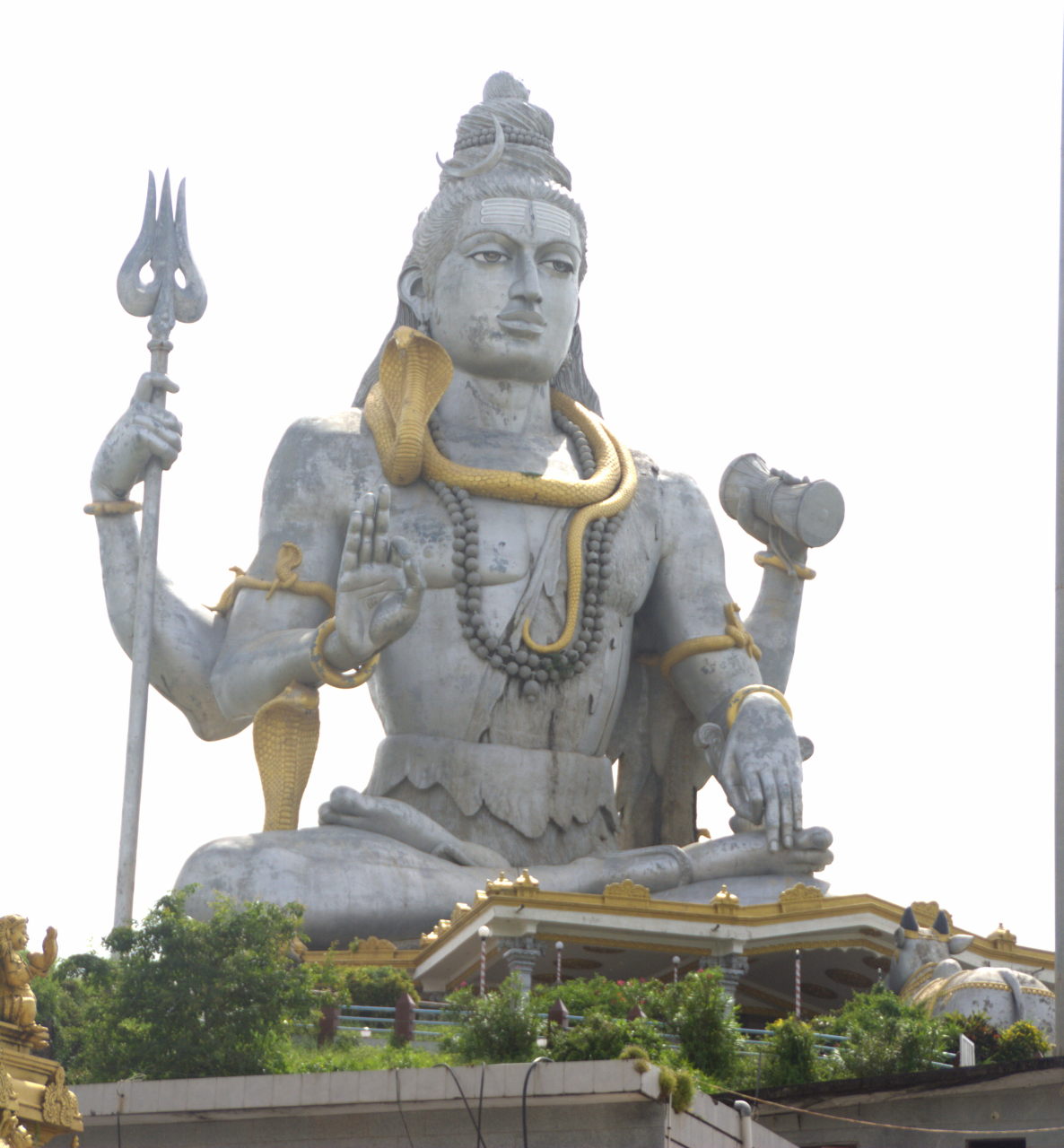
The 123 feet (37 metres or 12 storeys) tall Shiva statue at Murudeshwara temple. Compare its height to the tiny looking temple complex at the base of the statue.
Of all the beach temples, Murudeshwara is my favourite. The temple has so many features to see. First, the entrance is marked by a tall 237-feet Raja Gopura (entrance tower). There are two more tower once inside the Gopura. They are plated in gold. There are several statues, one showing the story of Shiv Bhakt Markandeya, another showing Lord Shiva releasing Ganga river from his dread-locks and another large statue showing the Sun God Surya Deva. The main highlight of Murudeshwara is the 123-feet tall statue of sitting Lord Shiva above the main sanctum.
Bhatkal is the town nearest to Murudeshwara, which has its own station named Murudeshwara Road. But if you are catching a superfast train, then you should alight at Karwar. Both towns have Karnataka & North West Karnataka state transport (KSRTC & NWKSRTC) buses to Murudeshwara. Murudeshwara has excellent lodging facilities in the form of the ample R. N. Shetty lodge, made possible by a man of that name. Mr R. N. Shetty is a businessman and regularly donates money for religious causes such as building and renovation of temples.
6. Varkala, Thiruvananthapuram district, Kerala
Similar to Gokarna, Varkala is popular among tourists, both foreign and Indian, as a beach resort town, similar to those in Goa. But Varkala is actually a Vishnu Kshetra with its flagship temple being the Janardhana Swamy temple. This temple is more than 2000 years old. The temple is 100 metres away from the sea, but the Bali Mantapa, or the sacrifice altar is on the beach. The beach’s name is Papanasam beach, meaning that it washes away the sins of those who take a dip in the sea.
Varkala has a station named ‘Varkala Shivagiri’. Other important railway stations in the vicinity of Varkala are Kollam Jn, Kochuveli and Thiruvananthapuram Central.
7. Kanyakumari, Tamil Nadu
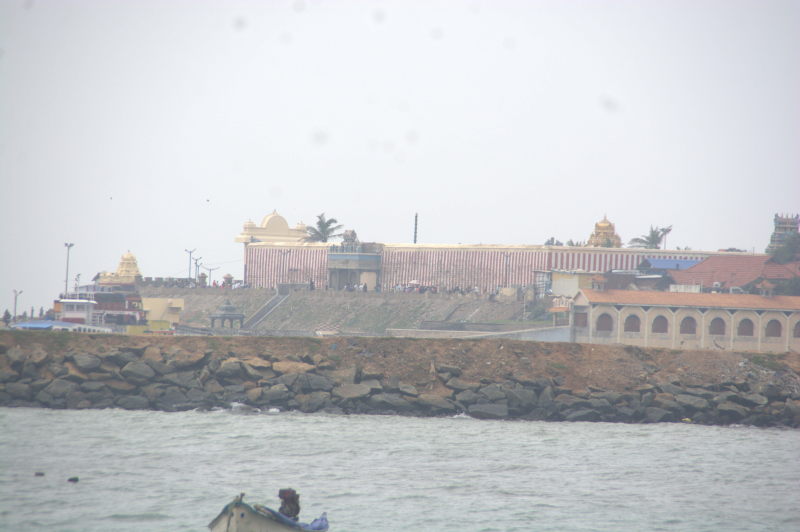
The temple due which gives the town its name. The Kanya Kumari Devi temple worships Bhagavathy Devi or Shakti in the form of an adolescent child, long before her marriage to Lord Shiva.
At the southern tip of India is a temple that overlooks the sea on three sides. The Indian ocean, the Bay of Bengal and the Arabian sea come together. Overlooking the confluence is the temple of Kanya Kumari, a form of Goddess Shakti, worshipped as an adolescent, long before Her marriage to Lord Shiva. Also important in Kanyakumari is a rock memorial paying respects to Swami Vivekananda.
Kanyakumari has a railway station and is connected to all major cities in India.
8. Thiruchendur, Thoothukudi district, Tamil Nadu
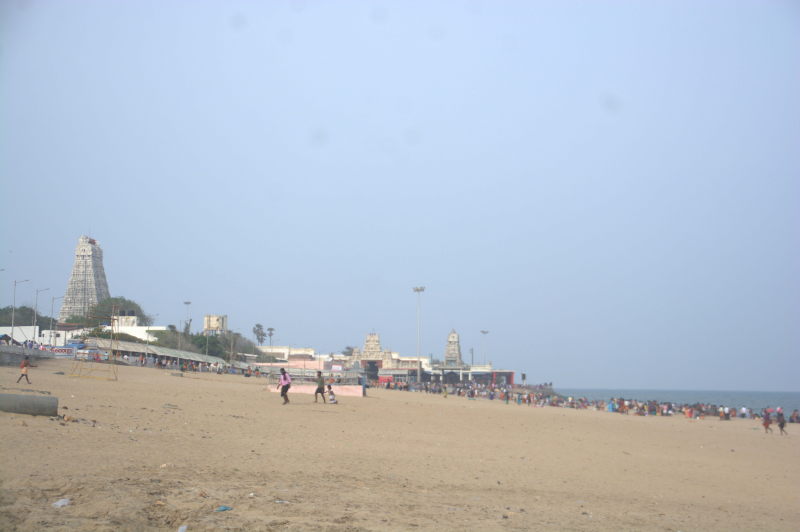
Thiruchendur beach temple is one of the 6 major temples worshipping Lord Murugan / Karthikeyan in Tamil Nadu.
In Tamil Nadu, there are six major Lord Murugan (Karthikeya) temples. These are collectively called the ‘Arupadai Veedu’s or the Six Abodes of The Lord. Four of them are at the top of hills. One of them is on the bank of Cauvery river, but still takes a flight of stairs to reach the shrine. The south-most Arupadai Veedu at Thiruchendur is on a beach. The town is between Thoothukudi (Tuticorin) and Kanyakumari. The name roughly translates to “Lord’s place with the red soil”, with the word ‘Thiru’ a way to address deities, the way ‘Shri’ is used in Sanskrit and word ‘Chendur’ being a Tamil form of the word ‘Sindhur’ or vermillion. This is due to the presence of red soil in this region of Tamil Nadu. There is nothing red about the beach though. Despite the influx of pilgrims, the beach is reasonably clean. The beach is also very long. It stretches for 2 km to the south of the temple, where you can find secluded quite places to hang out.
Thiruchendur has a railway station and is the terminus station on the railway route from Tirunelveli. Both Tirunelveli and Thoothukudi cities are about 50 km from Thiruchendur. Tamil Nadu state transport buses run between Thiruchendur and Tirunelveli, Thoothukudi and Madurai. Thiruchendur has plenty of lodges, Yatri Niwases and three-star hotels for a cosy stay.
9. Velankanni Church, Nagapattinam District, Tamil Nadu
If you want to see a shrine which has devotees from two religions alike, then Velankanni is a perfect example. What you see near the beach looks like a church and is definitely structured like a church with an altar and pews. But Christians and Hindus alike call the deity their own. The Christians from all over Tamil Nadu and even rest of India come here to pray to Mother Mary or Mary Amma. The Hindus have a slightly different target, calling the lady deity by the name ‘Mariamma’ or the rain god also known for her anger, similar to Goddess Kali. Candles and incense sticks burn side-by-side. The lady deity wears sashes and flower garlands. Offerings of fruits lie at the alter in front of the statue. People from both religions have made the place their own and co-exist harmoniously, truly believing in the concept of Many Faiths, One God.
Velankanni can reached easily from the railway station at Nagapattinam town, about 6 km away. There are state transport buses from Chennai, Thanjavur, Kumbakkonam and Pondicherry.
10. Ashtalaxmi temple, Chennai, Tamil Nadu
In the posh locality of Besant Nagar, on the Elliot’s beach, is a unique temple dedicated to Goddess Laxmi. According to Hindu mythology, there are eight forms of the Goddess, each one blessing Her devotees with a different form of wealth or abundance, thus leading to the prefix Ashta. The eight forms of Laxmi are: Dhanalaxmi (money), Dhaanyalaxmi (food), Dhairyalaxmi (courage), Santhaanalaxmi (offspring), Vidyalaxmi (knowledge), Vijayalaxmi (success), Gaja Laxmi (prosperity and royalty), Aadi Laxmi (also called Mahalaxmi, the consort of Lord Vishnu).
Like Mumbai’s Mahalaxmi temple, Ashtalaxmi temple is thronged by more devotees than usual during Diwali’s Laxmi Pooja day. Besant Nagar can be reached by taking Chennai’s super-reliable city buses. One can also take a local train on the MRTS route and alight at the Indira Nagar railway station.
Temples we did not cover
Due to time constraints on our trip, we did not cover Odisha. The Jagannath temple in Puri is one of the most important sea temples in the country and is part of the original Char Dham (4 abodes) route, combined with Badridnath (Uttarakhand), Dwarka (Gujarat) and Rameswaram (Tamil Nadu).
Conclusion
If you are a family with a mixture of religious and agnostic people, or a family with devout adults and fun-loving children, then beach temples are a perfect destination for you. Those who are touring with religion in mind can look around the temples and practise faith, while those less enchanted with religion can have fun on the beach. Of course, everyone can do a bit of both.

